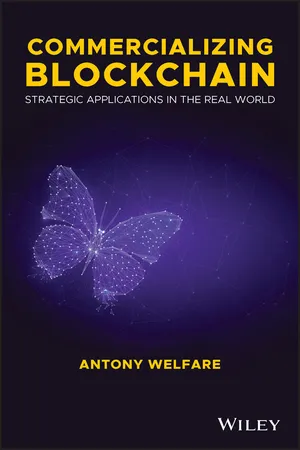
- English
- ePUB (mobile friendly)
- Available on iOS & Android
About This Book
The accessible, non-technical guide to applying and benefiting from blockchain technology.
Blockchain has grown at an enormous rate in a very short period of time. In a business context, blockchain can level the playing field between small and large organisations in several ways: Exact copies of the immutable, time-stamped data is held by all parties, all transactions can be viewed in real time, data blocks are cryptographically linked, all raw materials are traceable and smart contracts ensure no middle-men, ease of audit and reduced friction. The trust, transparency, security, quality and reduced costs of blockchain make it a game-changing technology that crosses sectors, industries and borders with ease. Even though the technologies are ready for adoption, businesses remain largely unaware of their full potential and effective implementation. End users require accurate and up-to-date information on the practical applications of blockchain — Commercializing Blockchain provides it.
A practical and easy-to-understand guide to blockchain, this timely book illustrates how this revolutionary technology can be used to transform governments, businesses, enterprises and entire communities. The author draws from his experience with global retailers, global technology companies, UCL Centre for Blockchain technologies, the government of the UK, Retail Blockchain Consortium and many other sources to present real-world case studies on the use and benefits of blockchain. Topics include financial transactions, tokenisation, identity management, supply chain transparency, global shipping and freight, counterfeiting and more. Provides practical guidance for blockchain transactions in business operations
- Provides practical guidance for blockchain transactions in business operations
- Demonstrates how blockchain can add value and bring increased efficiency to commercial operations
- Covers all of the essential components of blockchain such as traceability, provenance, certification and authentication
- Requires no technical expertise to embrace blockchain strategies
Commercializing Blockchain: Strategic Applications in the Real World is ideal for enterprises seeking to develop and deploy blockchain technology, particularly in areas retail, supply chain and consumer goods.
Frequently asked questions
1
Introduction to Blockchain Technology
Blockchain Technology Definition
What Are the Reasons Why We Have Blockchain Technology?
The Internet and Blockchain
The ‘Trustless’ World
- Do younger people trust banks? If they did why would the Monzo, Revolut, and Starling banks be growing so fast?
- Do younger people use Facebook? If they did, Mark Zuckerberg would not be facing government enquires for illegally selling its users' data.
- Is Google bringing back search results for you? Or has it been paid more to surface a different product to you?
- Is Uber cheaper, faster, and more comfortable than the centralized black cab world in London?
Banks give low interest so I wanted to invest a part of it (although cryptocurrency can be risky it really looks promising for the future).The technology itself. I do think blockchain has so many advantages that I think a lot of companies will be interested to invest in and will use it for the future.Power of the banks. Although banks claim crypto is a bubble, I don't trust them a lot. They have a lot of power and regularly they use it in the wrong way. Within cryptocurrency I believe people can control where and how much they can invest so you know what happens with your money.
- The internet
- Centralization
- The ‘trustless’ world.
Blockchain: The Internet of Value
Blockchain has Five Important Characteristics
- Blockchain for truth and trust
- Blockchain for transparency
- Blockchain for security
- Blockchain for quality and certainty
- Blockchain for efficiency.
1. Blockchain for Truth and Trust
2. Blockchain for Transparency
Table of contents
- Cover
- Table of Contents
- About the Author
- About the Contributors
- Foreword
- Foreword
- Preface
- Introduction
- 1 Introduction to Blockchain Technology
- 2 Types of Blockchain
- 3 Enterprise Blockchain
- 4 What Does Blockchain Solve?
- 5 Blockchain Powering the New Marketplace Model
- 6 Where Can Blockchain Technology Be Applied?
- 7 Blockchain Adoption
- 8 First Use Cases
- 9 What Makes It Work? Blockchain Best Practice
- 10 How to Commercialize Blockchain/Reach Its Potential
- 11 Risks of Implementing Blockchain Technology
- 12 Blockchain Is Better When Used with Existing and Other Emerging Technologies
- 13 Future of Blockchain
- 14 Use Cases in Real World – 2019 Highlights
- Retail Blockchain Consortium
- Index
- End User License Agreement